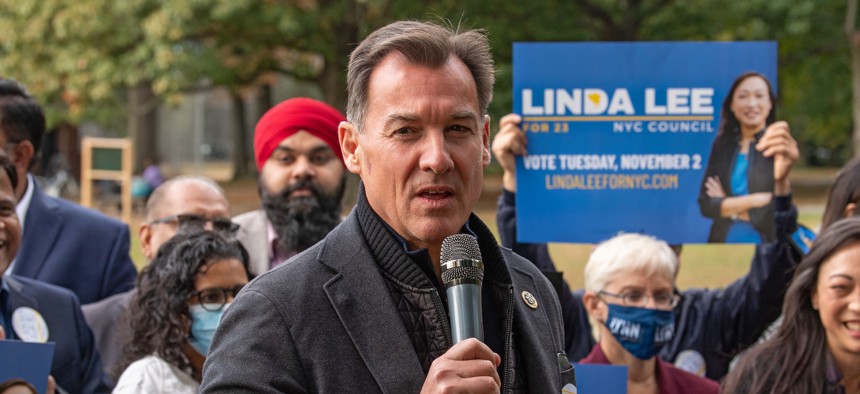Criminal Justice
New data proves bail reform both worked and failed, depending on who you ask
Supporters and opponents of bail reform in dueling press conferences point to a year worth of data released by the state to support their arguments.

Rep. Tom Suozzi, a Democratic candidate for governor, decried recent spikes in violent crime like murder. Ron Adar/Shutterstock
The state has released the first full year of data on bail reform, and it has both opponents and supporters claiming the numbers prove their points. Supporters have pointed to the low percentage of those released pretrial under bail reform – under 4% – who have been rearrested for violent felonies as evidence reform is working. Opponents meanwhile decry the high raw number – over 3,400 – as proof that lawmakers must make changes to the current bail system.
The stark disparity was on display on Tuesday, when dueling virtual press conferences scheduled for the same time took very different approaches to criminal justice issues. On one side, Rep. Tom Suozzi, a Democratic candidate for governor, decried recent spikes in violent crime like murder. “We've got a really serious problem in our state,” Suozzi said. “I don't think it's been talked about enough.” He didn’t attribute recent crime increases to any one particular factor, but he made sure to prominently highlight what he considered the negative effects of bail reform.
Suozzi directly referenced an article by the Times Union that garnered attention over the weekend for analyzing the raw data released by the state. It found that of the nearly 100,000 people released thanks to the 2019 bail reforms, under 4% were rearrested for a violent felony while awaiting trial, amounting to about 3,400 people total. Only about 1% of rearrests involved a gun. Overall, two-thirds of those released did not get arrested again, with the rest getting charged with nonviolent felonies and misdemeanors.
One may look at the small percentage of violent crime arrests among those released before their trial, but Suozzi focused on the raw number of alleged crimes, asserting it was far too many. “These are not just statistics, this is real life stuff,” Suozzi said. “Every single one of these crimes involve the victim involved somebody whose life is being ripped apart by a crime.” He advocated, as he has in previous campaign events, for changes to bail reform like permitting judges discretion to remand a defendant if they are deemed dangerous.
Suozzi did not offer specifics about how he would ensure that judges’ biases would not once again affect who gets detained before their trial. But he suggested that a system similar to the police CompStat – which tracks crime statistics in New York City – could apply to judges and their decision making. Suozzi said that “common sense” dictates that over 3,000 instances is a problem when asked by City & State the difference between the statistics that could be used with judges and the statistics that suggest a low rate of rearrest for violent crimes.
At the same time, criminal justice reform advocates – joined by new Manhattan District Attorney Alvin Bragg – held their own press conference to promote parole reform. Specifically, legislation that would enable incarcerated people over 55 who have served at least 15 years to become eligible for parole and another bill that would make it easier for anyone eligible to get paroled.
The two issues are of course not directly related, but the dueling press conferences offered very different pictures of New York – one where too many people are dangerously released and one where the state is not releasing enough people who should have that opportunity. “I think typically, it's not really about facts,” state Sen. Julia Salazar of Brooklyn told City & State. “It's about competing narratives about public safety.” She said that the bail data is far from complete, in part because there are no analyses to compare it to past years before bail reform, but contended that the available information doesn’t suggest bail reform poses a significant public safety threat. “Whatever is advantageous for them, the narrative that Congressman Suozzi or anyone else wants to push is what they're going to push,” Salazar said.
The debate over the relative success of bail reform played out in opinion pages and Twitter as well. The New York Post published an editorial blasting Assembly Speaker Carl Heastie over bail reform, pointing to the anecdotal evidence of its failure on Dec. 29. Heastie shot back at the paper Tuesday on Twitter, calling the editorial “overly biased (and) one-sided.” He linked instead to a Times Union editorial which took a more balanced view based on the state data and concluded that it’s still too early to draw conclusions about bail reform. Still, activists from both sides used that data for vindication – it’s either “nearly 4%” rearrested for violent crimes and a whopping 1 in 3 total rearrested, or it’s “only 4%” with a two-thirds majority of defendants committing no new alleged crimes.
The point may be moot with Democratic supermajorities in both chambers of the state Legislature, most of whom – including leaders – have publicly expressed little interest in making further changes to the bail system. But with Eric Adams freshly in office as New York City’s new mayor and pushing for more reforms to the reforms, revisiting the contentious issue surely is not totally off the table.
– With reporting by Zach Williams

